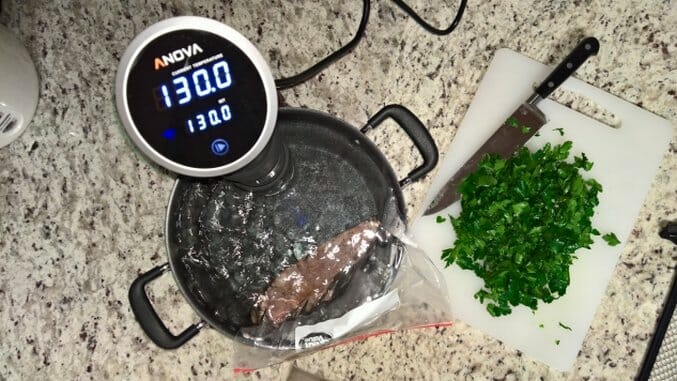Anova WiFi Precision Cooker: Cook Like a Chef

Imagine enjoying the most savory cut of steak from Chef Thomas Keller’s famed French Laundry menu. Thanks to Anova’s connected smart sous-vide cooker, you can recreate the juiciest meats, poultries, seafood and even desserts from restaurant-inspired menus in your kitchen at a fraction of the cost and with minimal preparation.
Unlike cooking on a stovetop or an oven, both of which require higher temperatures, the sous-vide cooking method will cook your food in a water bath at a precise temperature for a set time, similar to slow cooking. Lower temperatures and longer cook times produce flavorful results, with meats that are tender and juicy.
Design Like the Bluetooth-only model that it replaces, Anova’s new Wi-Fi and Bluetooth model is a large cylindrical 15-inch black and silver wand fashioned from plastic and stainless steel. Build quality is sturdy, and the black plastic is coated with a nice matte soft-touch material, making it pleasant to hold and touch. The stainless steel skirt at the bottom is removable for washing.
Like the Bluetooth-only model that it replaces, Anova’s new Wi-Fi and Bluetooth model is a large cylindrical 15-inch black and silver wand fashioned from plastic and stainless steel. Build quality is sturdy, and the black plastic is coated with a nice matte soft-touch material, making it pleasant to hold and touch. The stainless steel skirt at the bottom is removable for washing.
The sous-vide cooking instrument comes with a plug for power, a sturdy cylindrical mounting bracket, allowing the device to be clipped onto a variety of pots, pans and tubs, and a touchscreen interface up top with a scroll wheel mounted on the side.
The on-device controls allows you to operate the sous-vide locally, while WiFi adds the flexibility of starting your cook remotely. The latter option means you can have a hot meal ready for you by the time you get home from work — we’ll get into the benefits of adding smart connectivity to a kitchen appliance later in this review.
As a non-chef, I was initially intimidated by anything in the kitchen, but the sous-vide method requires minimal preparations and simple ingredients. Unlike eating out, you have more control over the quality of your meals — if you buy more premium meats, for example, your results will be on the higher side. Anova Culinary provides a number of curated recipes that work with the Anova Precision WiFi Cooker collected from chefs and its avid user base.
Setup Setting up the Anova was extremely easy. You’ll need to clamp the Anova with its adjustable mounting bracket, which looks like a vice with a circular ring to pop the sous-vide into place, to a large pot or receptacle of water. If you’re using the Anova as a standard cooking tool, you can use the controls on the device to set the time and temperature of your cook right on the device itself, but if you want to be able to start or stop the cooking process remotely, you’ll want to download the Anova WiFi app on your iOS or Android device and go through the steps to pair the Precision Cooker with your phone.
Setting up the Anova was extremely easy. You’ll need to clamp the Anova with its adjustable mounting bracket, which looks like a vice with a circular ring to pop the sous-vide into place, to a large pot or receptacle of water. If you’re using the Anova as a standard cooking tool, you can use the controls on the device to set the time and temperature of your cook right on the device itself, but if you want to be able to start or stop the cooking process remotely, you’ll want to download the Anova WiFi app on your iOS or Android device and go through the steps to pair the Precision Cooker with your phone.
In order to connect the Anova to your home’s WiFi network, you’ll need to pair the Precision Cooker to your phone via Bluetooth. The app will then transfer your WiFi credentials to the Precision Cooker over Bluetooth. I found the process to be easy, but it did take several tries to connect my iPhone to the Precision Cooker using Bluetooth — I used a friend’s iPhone and it worked on the first try, so I am not sure if it’s an iOS issue or just Bluetooth acting up.
From the app, you can browse Anova’s recipes, view portions, preparation time, cook time and ingredients. For the time being, Anova is over-complicating its IoT kitchenware with dueling apps — one for the Bluetooth model and another for WiFi. The Bluetooth app lets you browse recipes and comes with features, while the WiFi app is more simple, displaying cooking controls. Anova told me that the company will merge the two apps over time to integrate the features. If you want to browse recipes, you’ll need to download the basic app, and then you’ll use the Anova WiFi app to start your cook.
If you’d rather not deal with the apps, Anova also posts its recipes on its website, so you can start there to get your inspiration.
Cooking To test Anova’s claims of delivering perfectly cooked foods, I tried the Precision Cooker using some more difficult ingredients that are harder to control when cooking on the stove. I opted to try cooking London broil, which is a leaner cut of meat that’s often tough, and scallops to create a surf and turf plate.
To test Anova’s claims of delivering perfectly cooked foods, I tried the Precision Cooker using some more difficult ingredients that are harder to control when cooking on the stove. I opted to try cooking London broil, which is a leaner cut of meat that’s often tough, and scallops to create a surf and turf plate.
-

-

-

-

-

-

-

-

-

-

-

-

-

-

-

-

-

-

-

-

-

-

-

-

-

-

-

-

-

-

-

-

-

-

-

-

-

-

-

-

 The benefit of Wi-Fi connectivity is that the preparation time is under ten minutes for both dishes. This means that I can prep my ingredients in the morning before heading out to work, and then instead of filling my pot with water, I can set it in an ice bath. Then, I can time it so that two hours before my ETA at home, I can begin my cook, and then I can come home to freshly cooked steaks. This allows me to have a healthy, natural meal with minimal effort right when I get home, instead of arriving home and waiting another two hours for my food to be ready.
The benefit of Wi-Fi connectivity is that the preparation time is under ten minutes for both dishes. This means that I can prep my ingredients in the morning before heading out to work, and then instead of filling my pot with water, I can set it in an ice bath. Then, I can time it so that two hours before my ETA at home, I can begin my cook, and then I can come home to freshly cooked steaks. This allows me to have a healthy, natural meal with minimal effort right when I get home, instead of arriving home and waiting another two hours for my food to be ready. Fans of the sous-vide method swear by it, and even though sous-vide is starting to slowly gain traction in homes, it’s been a staple inside restaurants. The reasoning, explained Anova CEO Stephen Svajian at the company’s San Francisco headquarters, is that you’ll get a more even cook. If you’re cooking a thicker slab of meat and want the center of the cut cooked medium, for example, the traditional way of cooking means that the edges are over-cooked.
Fans of the sous-vide method swear by it, and even though sous-vide is starting to slowly gain traction in homes, it’s been a staple inside restaurants. The reasoning, explained Anova CEO Stephen Svajian at the company’s San Francisco headquarters, is that you’ll get a more even cook. If you’re cooking a thicker slab of meat and want the center of the cut cooked medium, for example, the traditional way of cooking means that the edges are over-cooked.






































